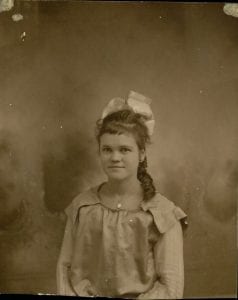
by Amanda Neel, Graduate Assistant
Before Judge Drummond Webster Bartlett (1895-1963) began his illustrious law career and made national headlines for presiding over the world’s first televised trial in 1952, he was a social young man attending junior college.
This portion of his life is now a part of The Texas Collection through a donation of documents, known as the Drummond Webster Bartlett papers, 1911-1921. A sampling of letters drawn from the collection gives insight into the lives and minds of young adults in the early 20th century, specifically the years between the start of World War I and the United States’ entrance into the war in 1917.

The largest portion of letters span the years 1915-1917 and come from Lois Kirby, a sweetheart of Drummond’s. Her letters showcase how the concerns of young Texans evolved through the years of World War I. Even though World War I started in 1914, Lois’ letters concerned parties, social calls, her work as a teacher, and, of course, her love and concern for Drummond. Not until 1917 does Lois address the war; she writes, “Everyone here seems to be getting enthused over the war. A Red Cross auxiliary was organized here last night.”

A year later, Drummond joined the war effort himself. Another sweetheart, Nelle Gentry, wrote to Drummond in support of his military effort. In a letter addressed to her “Darling Soldier,” Nelle writes, “I have been crazy with joy for you…because you answered your country’s call and have given all ties of home and loved ones to go and do you[r] bit.” Her following letters contain accounts of friends and acquaintances involved in the war effort, as well as lines about her enduring love for Drummond.
Sadly, we do not have Drummond’s responses to the letters from his sweethearts. Though the sentiments expressed through the letters speak of undying love, the relationships did end. Bartlett’s marriage took place outside the scope of this collection. In 1933, Drummond Bartlett married a woman named Bessie Opal Smith. They remained together until Bartlett’s death in 1963.
Along with letters from sweethearts, Drummond’s papers also contain materials from his life as a junior college student, including homework assignments, society publications, and yearbooks. Also in the collection are military records documenting Drummond’s answer to the draft and his discharge in 1919, as well as a plethora of photographs that visually document his early life.


![Tomlin, Henry. Courtship and Marriage of Henry Tomlin. [Dallas?]: [publisher not identified], [1908?]. Print.](https://c1.staticflickr.com/3/2874/34301673685_8a91004bab_o.jpg)
![H.J. Justin & Sons. Justin Boots & Shoes. [Fort Worth?]: [publisher not identified], [1947?]. Print.](https://c1.staticflickr.com/3/2806/34301669055_f6ca305841_o.jpg)
![Street Car and Bus Service in Dallas: Information for Centennial Visitors and Home Folks. [Dallas?]: [publisher not identified], [1936]. Print.](https://c1.staticflickr.com/3/2827/34301663995_e75f8d7846_o.jpg)



